Firebase Summit 2018: A Brief Summary

At the end of last month, a Firebase Summit 2018 conference was held in Prague, dedicated to Firebase services, many of which now claim to be the standard in the mobile application development industry. I will try, albeit with a delay, but to tell you that I managed to hear and see interesting things. In this article we will consider announcements (translation of the official press release ) with my corrections and comments.
A brief description of some of the Firebase services, which will be discussed later.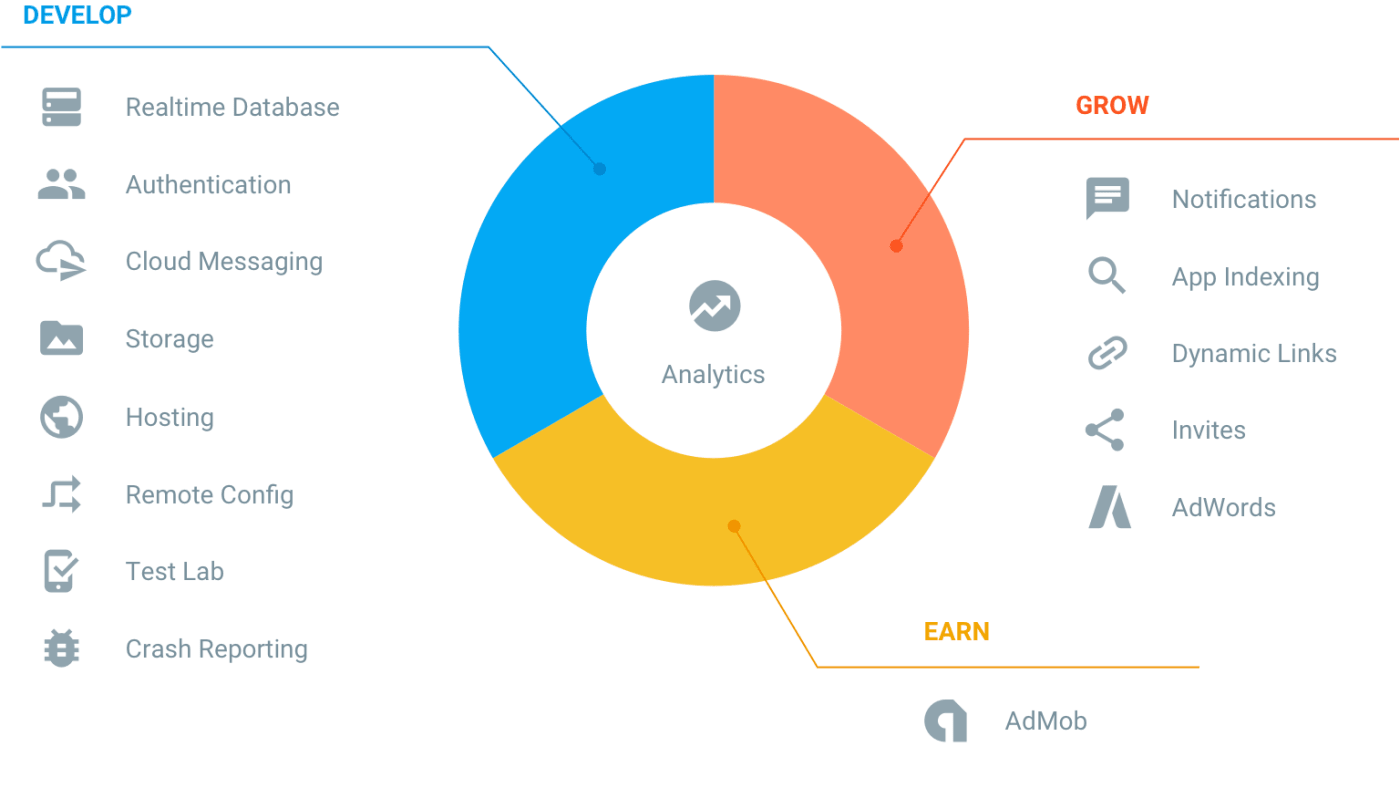
Полный перечень сервисов Firebase.

Полный перечень сервисов Firebase.
- Firebase Remote Config – облачный сервис для удаленной настройки конфигурации приложения.
- Firebase ML Kit – облачный сервис для использования моделей машинного обучения в мобильном приложении. Доступны как высокоточные, предварительно обученные модели глубокого машинного обучения, так и кастомные модели.
- Firebase Cloudstore – масштабируемая облачная NoSQL база данных.
- Firebase Realtime Database – облачная NoSQL база данных реального времени.
- Firebase Test Lab – облачная ферма устройств для тестирования мобильных приложений.
- Firebase Performance Monitoring – облачный сервис для мониторинга ключевых показателей производительности в мобильных приложениях.
- Firebase Crashlytics – облачный сервис для отслеживания и анализа багов в мобильном приложении.
- Firebase Cloud Messaging – облачный сервис для отправки push-уведомлений в мобильные приложения.
Key announcements:
- Support for Firebase services will soon be included in the Google Cloud Platform support package.
- Published Firebase Management API, a new service that allows you to programmatically manage Firebase projects.
- The updated model for face recognition in the ML Kit now identifies more than 100 key points on the face.
- The function of converting and compressing TensorFlow-models was transferred to alpha testing.
- Local emulators for Cloud Firestore and Realtime Database are released.
- In Cloud Functions added triggers Remote Config.
- The Test Lab device farm for iOS has been released from testing.
- Performance Monitoring added more detailed analysis of user sessions.
- Added integration of Crashlytics with PagerDuty and BigQuery, published templates for data visualization in Data Studio.
- Predictions has gone out of testing for sharing.
- Added new settings for working with audiences in Google Analytics for Firebase.
- In Firebase Cloud Messaging added the ability to configure automatic targeted mailings.
Below you can find more information about each of the announcements.
Firebase Support Services
Support for Firebase services will be included in the Google Cloud Platform (GCP) support package, and the beta version of the support will be available by the end of the year. If you have already purchased the GCP support package, the beta version will allow you to ask questions on Firebase through the GCP support channel at no additional cost. As soon as the function becomes publicly available, guaranteed response time and technical support for corporate customers will be introduced. Details on GCP support can be found here .
If you would like to continue to work with free support for Firebase, do not worry, Firebase does not plan to reform the current model . One of the most common ways to interact with Firebase right now is their official Slack forum.if you have not seen it yet, I advise you to read it.
Development Tools
Firebase Project Management with Firebase Management API
The Firebase team launched the Firebase Management API - the REST API, which allows you to create and manage Firebase projects programmatically. The Management API is designed for deeper integration of the Firebase ecosystem into the company's existing workflow. In addition, the Management API will allow partner services to facilitate interaction with the Firebase ecosystem. For example, it is now possible to deploy projects to Firebase hosting directly via the StackBlitz and Glitch development environments . Their platforms automatically recognize the application created by Firebase and prompt you to deploy them to Firebase hosting without leaving the platform itself. The coolest thing is that this feature is available not only to partners, but to all Firebase users. You can learn more about it and get started.here .

Deploy Firebase project to StackBlitz.
Improved Face Recognition in ML Kit
The ML Kit, presented at the Google I / O conference in May, makes machine learning easy and affordable for all developers, regardless of their experience. If this area is not very familiar to you, you can use the built-in API to recognize, for example, text or faces. If you have experience in machine learning, you can download your own TensorFlow Lite models and support them via Firebase.
An updated face recognition API was introduced on the Firebase Summit. As part of the beta version, a face contour definition was added to it, which allows identifying more than one hundred points on and around the face. The function will allow, for example, with high accuracy to impose masks on faces or to carry out retouching: smoothing the skin or changing the tone. You can learn more from the documentation.
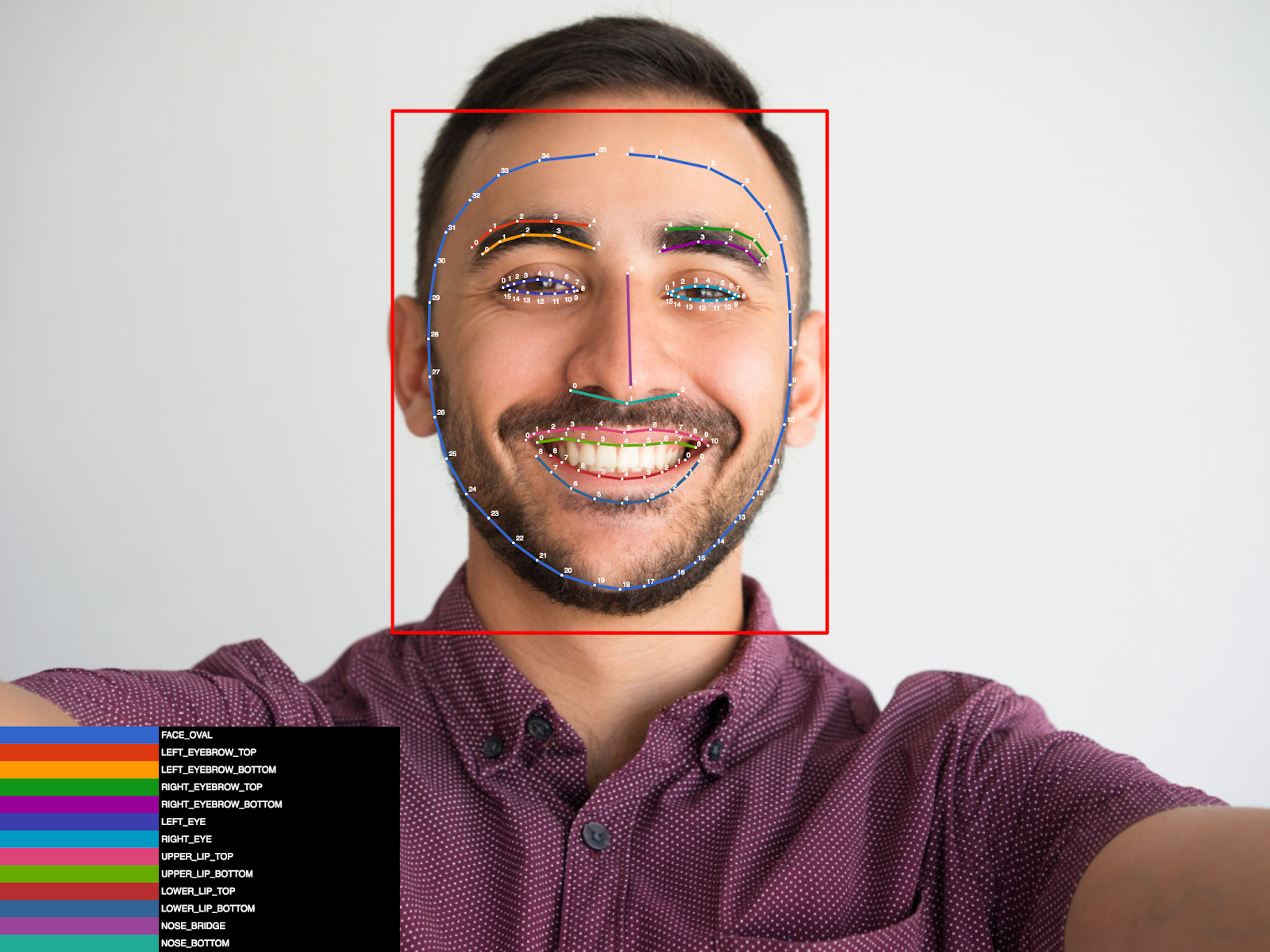
Detection of facial contours with the help of ML Kit.
Alpha version of the conversion and compression of TensorFlow-models in the ML Kit
On Google I / O, the automatic conversion of TensorFlow-models to TensorFlow Lite with parallel compression was announced, which has now been released in alpha testing. This feature is based on the technology Learn2Compress, you can read more about it in the Google blog . As an example of use, the social platform Fishbrain was given, which managed to compress the model for classifying images from 80 MB to 860 KB, while maintaining accuracy rates at about the same level. Despite the fact that this feature is not indicated in the official press release, you can learn about it from the recording of the speech at the conference.

Convert TensorFlow-model to TensorFlow Lite and parallel compression.
Local emulators for Cloud Firestore and Realtime Database
Testing applications can be difficult, especially if they use Firebase file storage and databases. For example, a rather laborious task is to set up rules for accessing information in the Realtime Database, which had to be tested immediately in production. To solve these problems, local emulators for Cloud Firestore and Realtime Database were launched . Emulators allow you to develop and test locally, and can also be built into the testing process and continuous integration. Read more about emulators here .
Remote Config and Cloud Functions Integration: update configuration in real time
Firebase Remote Config is quite convenient for remote control of application configuration, for example, for customizing the interface, conducting A / B tests and rolling out new features without updating the application in Google Play. However, the mechanism for obtaining configuration data on the client could not be called flexible: by default, the information was updated no more than once every N hours. This provided a significant delay between the time the update was published in the configuration and the moment the user received it. Triggers to Firebase Remote Config events
have been added to Cloud Functions for Firebase , which now allows you to initiate a call to the Cloud Functions function when making any changes to Remote Config.
For example, using this feature, you can now update the Remote Config configuration on client applications in real time. To do this, when changing the configuration data, you should send a push via Firebase Cloud Messaging to the client application, so that it, in turn, updates Remote Config. Detailed instructions on how to do this are here .

Remote Config update in mobile applications in real time.
Tools to improve the quality of the application
The release version of Test Lab on iOS
Beta testing of the Firebase Test Lab for iOS, announced on Google I / O, has been officially completed, Firebase has opened the Test Lab for iOS sharing. In addition, over the past months, the farm of iOS devices has been increased, support for iOS 12 and older versions of the system has been added. More information in the documentation .
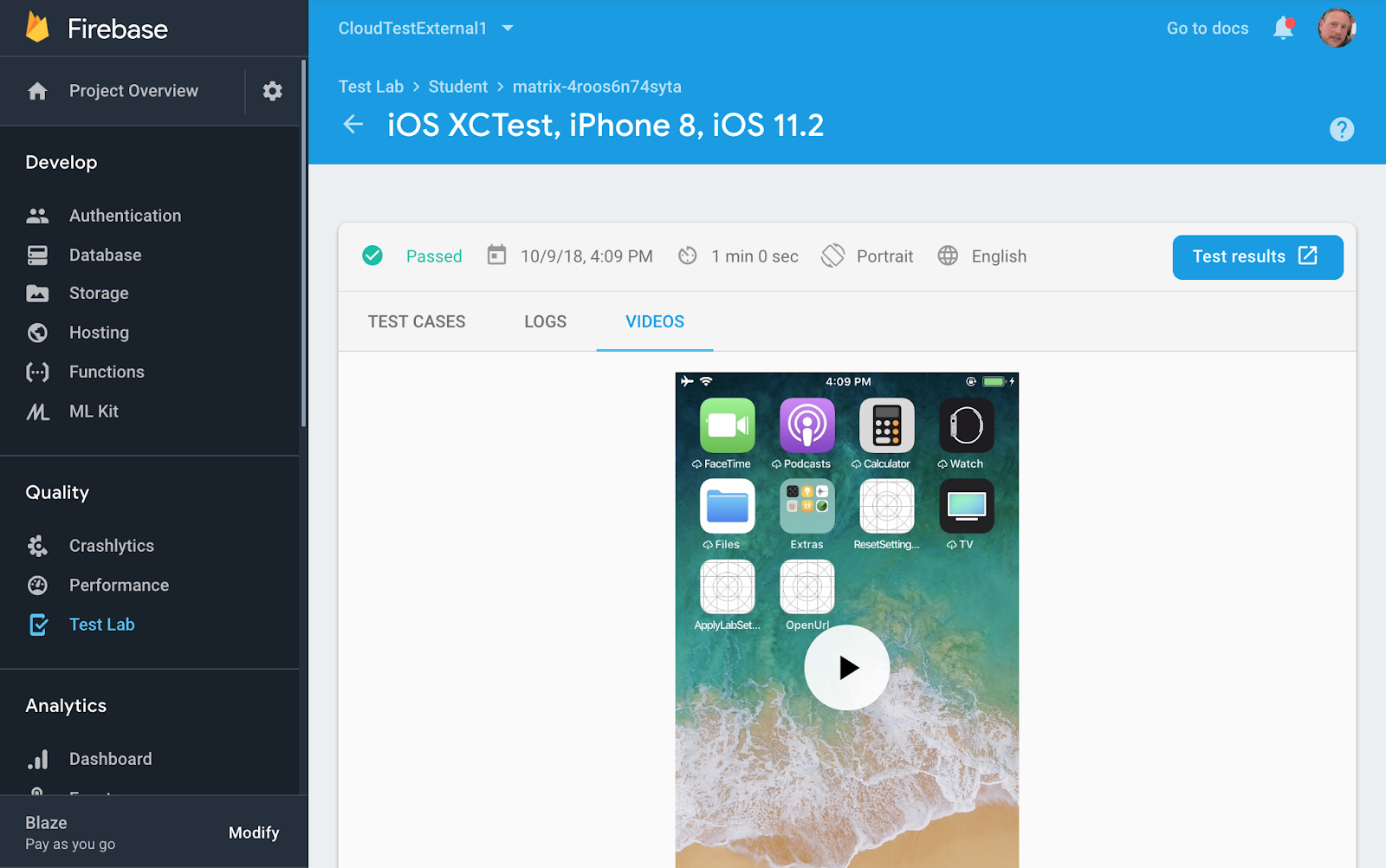
Test Lab on iOS.
Performance Monitoring: session analysis and work with bugs
In Performance Monitoring, we added the ability to analyze the trace of an individual user's stack in order to understand what exactly preceded a decrease in performance. For example, the screenshot below shows that the CPU load jumped when the application loaded and displayed the product logo on the screen. This information will tell you where in the code to look for the error.

User session analysis in Performance Monitoring.
With an abundance of information and many problems that Performance Monitoring helps to find, it can be difficult to prioritize. For this purpose, the Firebase team added functionality for working with bugs, namely the ability to turn off problem alerts, close a problem, or reopen a problem. Turning off alerts allows you to escape from the problem and focus on other tasks. The mark “closed” means that the problem is solved, but if it returns, Firebase will automatically send a notification. More information about new features in Performance Monitoring can be found here .
Integration of Crashlytics with PagerDuty
In addition to the new email newsletter with the application stability report, Crashlytics has been integrated with PagerDuty. The digest will indicate problems that may cause a lot of trouble in the future, and integration with PagerDuty will allow you to notify your colleagues in the event of a crisis at any convenient time. Read how to integrate here .
Integration of Crashlytics with BigQuery and Data Studio
A few months ago, the integration of Crashlytics with BigQuery was completed, with the help of which you can now make a deeper analysis of application crash data. To make it easier to get started with BigQuery, Firebase has published a Data Studio template with which you can quickly generate a report and share it with the team. Detailed information on the link .
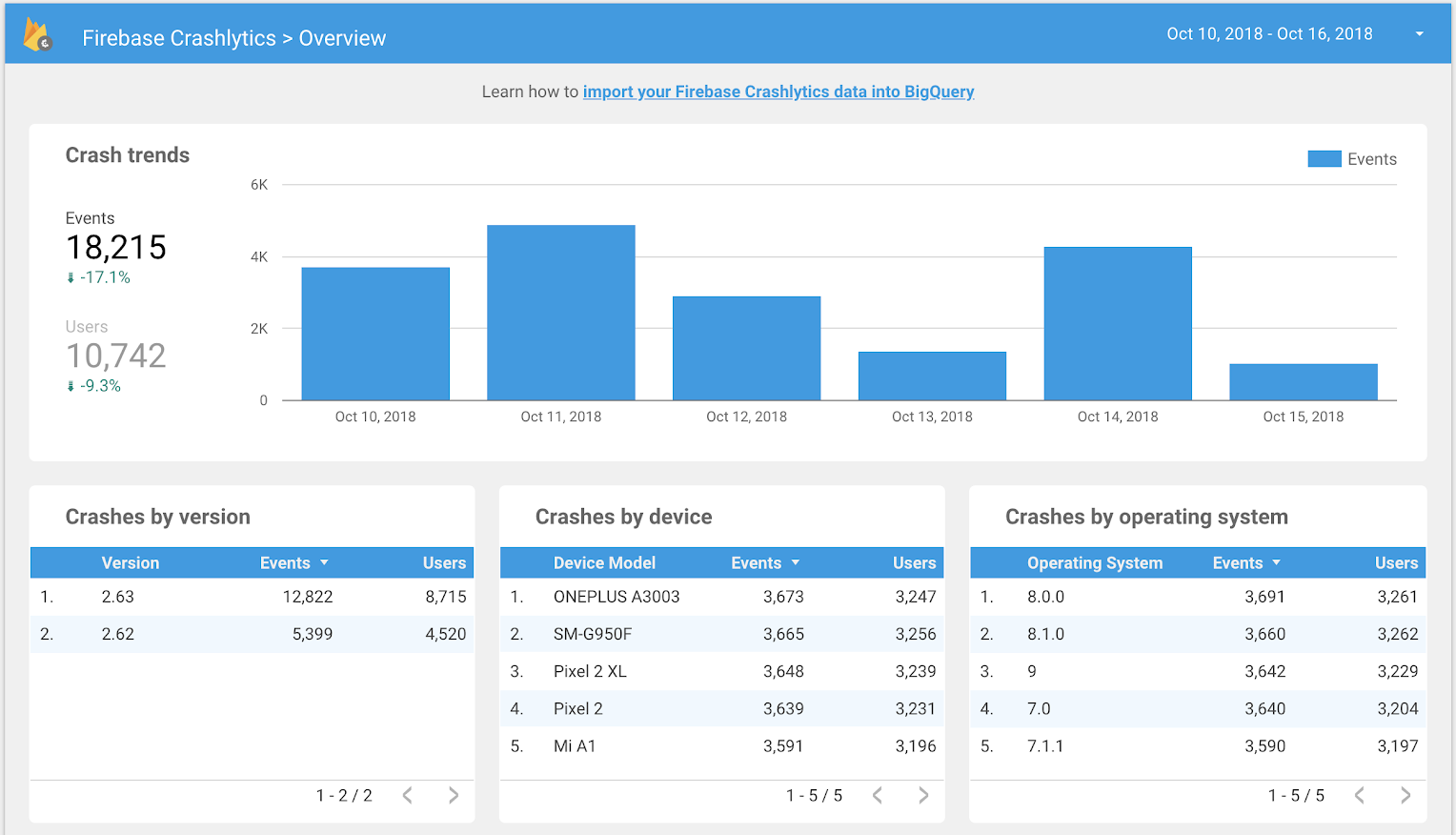
Template for Data Studio.
Tools for working with analytics
Predictions release version
At last year’s Firebase Summit conference, the Firebase Predictions service was introduced , which, according to data from Firebase Analytics, segments users regarding predicted actions using machine learning methods.
This allows you to get an idea of which users are more likely to refuse an application, and who will make a purchase or perform any other conversion action, without immersion in data analysis and machine learning.
At the conference, it was announced that Predictions is going out of beta version and will receive a number of new features. First, for each forecast, extended information will be added on the factors taken into account by the model (events, device, user data, etc.). Secondly, each report will be accompanied by a forecast quality infographic, which can be used to track which predictions were better than the others. And, thirdly, for those who want to get a deeper analysis of forecasts or to use data in working with other services, export of predicted data to BigQuery will be available. Details on the link .

Forecast in Firebase Predictions.
Updated audiences in Google Analytics for Firebase
If previously users were divided into audiences in Google Analytics for Firebase depending on events, device type and other static characteristics, now several fundamentally new settings appear.
- Dynamic audience. Now the audience is dynamic by default: Firebase will automatically include suitable users in them and exclude those who are no longer subject to the specified criteria. For example, if you target ads to users who have reached level 5 in your game, then users who have reached level 6 will automatically be excluded. Similarly, users who have reached level 5 will enter the desired segment.
- The criteria for exclusion from the audience. Now you can filter your audience by adding exclusion criteria that will allow you to form audiences like “users who added a product to the basket but did not buy it”.
- Manage user lifetime in the audience. This function allows, for example, to target users who performed the action you need in a certain period of time, for example, “made a purchase in the last two weeks”.
Get more information and start working with the updated service here .
Automatically send targeted push notifications to Cloud Messaging
A new web interface, Firebase Cloud Messaging, allows you to configure automatic distribution of push notifications (including periodic ones) when new users are added that meet the specified criteria. For example, you can send notifications by the date of their first or last application launch. Also, the push efficiency screen has been updated. Get to know the new UI closer .
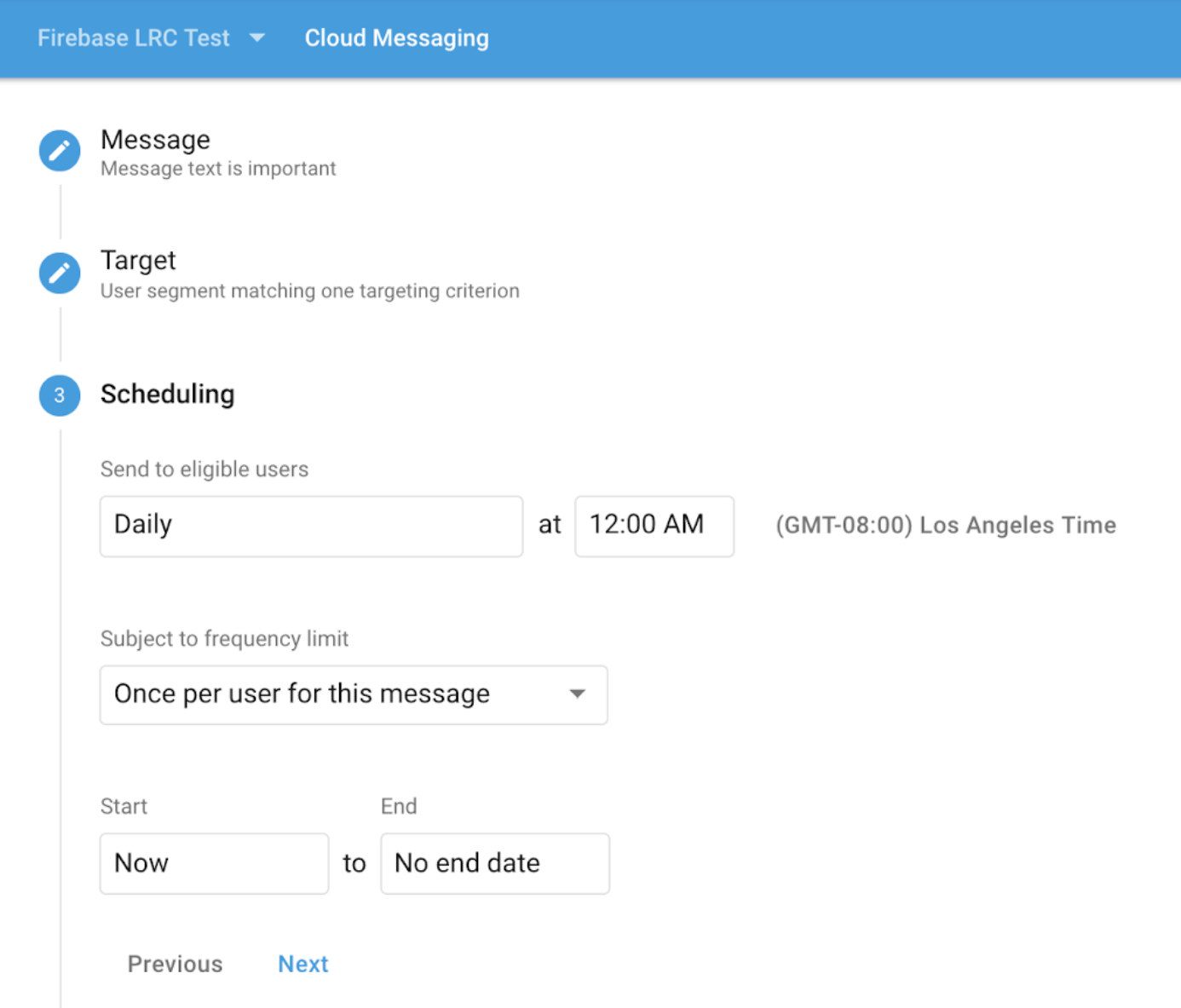
Configure a schedule for sending push notifications in Firebase Cloud Messaging.
And where to look?
All reports are available on YouTube , a brief video review of key announcements can be found here .
